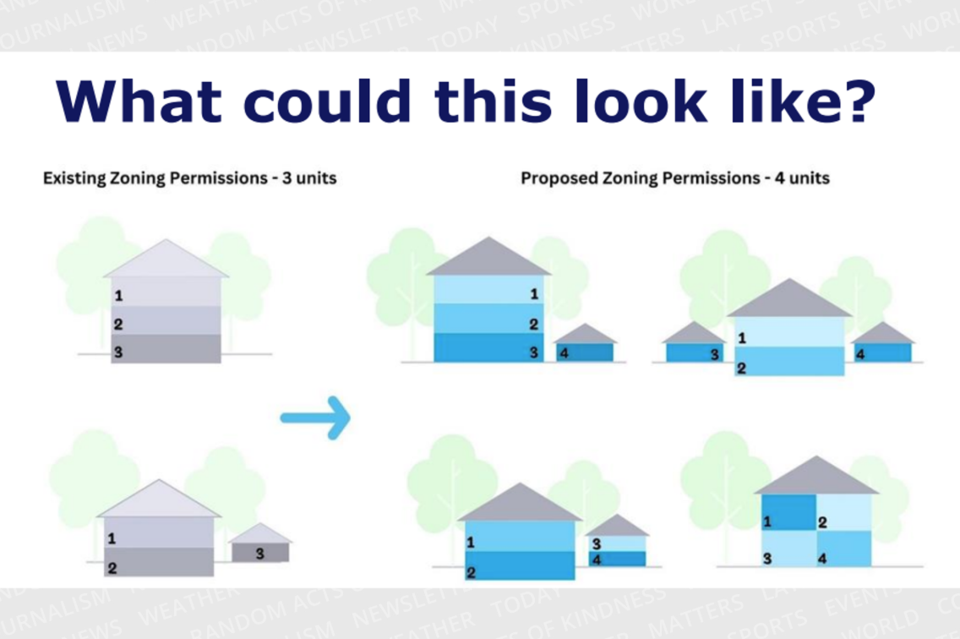Changes are likely on the way for a proposal that could see neighbourhood density increased in areas throughout the city, with the largest impact expected in older areas that have larger lots.
During a public meeting on Tuesday, city council heard numerous concerns about a draft bylaw that, if approved, would allow four residential units on individual lots in low and medium density areas – from increased traffic and on-street parking problems to lessened greenspace and noise issues.
It also heard suggestions on ways to refine the draft bylaw to limit the impact on existing residents, with councillors floating a few balloons of their own. Among the ideas put forward are setting a limit on the number of collective bedrooms per property, limiting the number of four-unit properties in any given area, and requiring the property owner to live in one of the units to prevent absentee landlords.
There was also talk of allowing four-unit properties as a pilot project and/or revisiting the idea after a few years to review its impact.
It’s not so much the idea of individual four-unit properties that inspired concerns, but the cumulative effect of multiple.
“This is not ‘gentle density’ to the average citizen,” said delegate Philip Maher, noting the bylaw could allow a four-bedroom home to be turned into four units with a dozen or more bedrooms. “Calling this gentle density is misleading. You can put lipstick on a pig but it’s still a pig.”
Like others, Maher acknowledged there may be sites where four units would be appropriate. However, he urged council to reject the blanket bylaw and retain the process where developers have to get special permission from council for this type of project.
“I’m kind of losing my mind over this, along with many other residents,” said Annia Kycia, who expressed particular concern about the quantity of four-unit properties in any given neighbourhood, along with the lack of a cap on bedrooms. “We cannot underestimate the impact this intensification would have on our roads, on our safety, on our lives and on the lives of our children.”
This bylaw, if approved, has the potential to impact much of the city, Kycia said.
The Ontario Building Code sets the minimum size for bedrooms, staff noted, adding four-unit properties will only be allowed only if there is existing capacity in the water and sewer systems to accommodate the additional residents.
If ultimately approved – something council is set to consider in June – the revised zoning rules would allow for a primary residence and three additional dwellings on a single property in low and medium density areas.
Unless an exception is granted, the current cap is two accessory units.
Under the draft bylaw, there are to be no more than two detached, accessory units per property; no limit is set on the quantity of bedrooms; connection between the primary unit and accessory units within the same building would no longer be required, though outdoor staircases would be banned in front and exterior side yards; and fourplex buildings would require three parking spaces, while four would be needed in the case of separate buildings.
Also, accessory units are to be smaller in size than the primary residence.
The draft bylaw regulations include no change to minimum lot size and frontage restrictions, landscaped open spaces, minimum setbacks, height restrictions or driveway widths.
At the moment, Guelph has about 32,000 low-density residential lots which provide roughly 36,000 housing units, the report states. Of those lots, about 27,000 include only one unit.
The only delegates who spoke in favour of the draft bylaw without calling for changes have a direct financial interest in seeing it approved – an infill developer and the Guelph and District Association of Realtors (GDAR).
“It represents a forward-thinking approach to housing, one that acknowledges the urgent need for increased housing supply and diversity in Guelph,” said Dillon Fraser, GDAR president. “By approving this bylaw amendment, we can take a bold step towards meeting our housing goals, encouraging innovation in housing solutions, and making Guelph a model for gentle density and sustainable city living.”
The only council member to express support for the draft bylaw – most simply asked questions, without stating their opinion – was Mayor Cam Guthrie, who has the ability to overrule the rest of council.
“In a housing crisis … we’re supposed to be trying to save (developers) time, trying to make things easier,” Guthrie said, noting eliminating the need for zoning bylaw changes would cut up to 90 days off the approval process. “We need more housing.”
City staff is currently looking into the possibility of allowing five-unit properties in low and medium density areas, with that draft bylaw expected to be released for public feedback and council’s consideration later this year.
